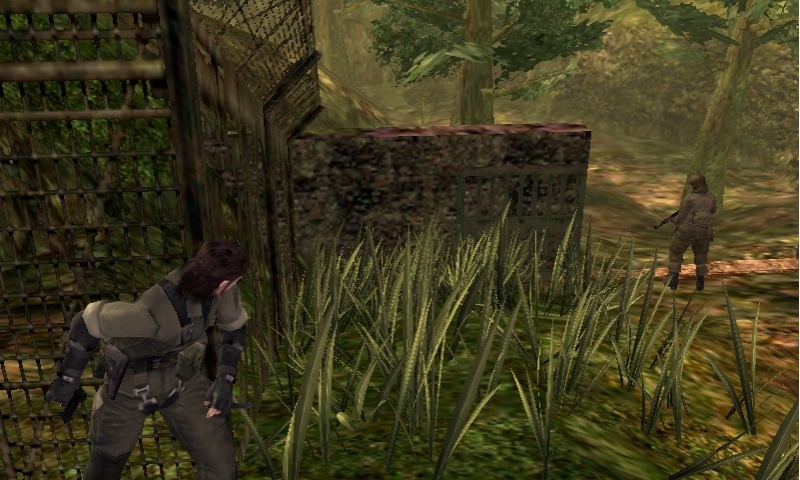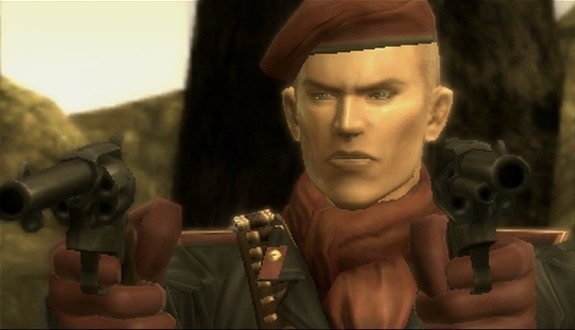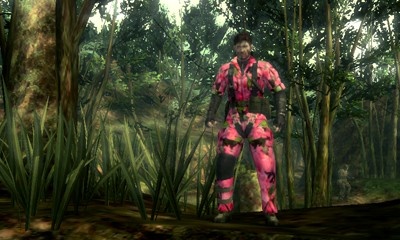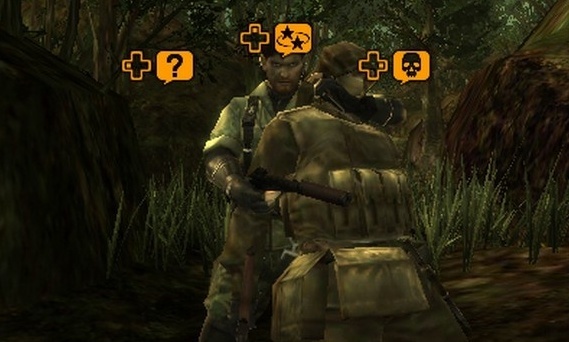Nintendo has been stiffed for nearly a decade; the last Kojima Productions game to appear on a Nintendo platform was Metal Gear Solid: The Twin Snakes, a remake of the original Metal Gear Solid for the GameCube. Eight years later, Nintendo fans are finally getting another taste of Snake. It's a remake, but it's of arguably one of the best entries in the series. Metal Gear Solid: Snake Eater 3D is based on the PlayStation 2 original released in 2004. Much has changed since then, and Snake Eater has been updated to cater to contemporary expectations. It's very much the same game, but the updated controls and visuals make this remake on the 3DS the best version of the game to date.

For the uninitiated, you play the part of CIA operative Naked Snake (known as "Big Boss" in later games) on a covert mission in Soviet territory. Your mission is to destroy a mobile missile launcher, the Shagohod, capable of firing nuclear payloads at the United States from any terrain. As you maneuver Snake toward his goal, you infiltrate enemy territory using your environment to shield your presence from the watchful gaze of the enemy.
If you're stealthy enough, you can achieve a Zen-like state of sneakiness, for lack of a better word. Should you fail to move undetected, alerting the enemy to your presence initiates a chaotic scramble that destroys any semblance of focus you may have conjured. It's a rewarding and challenging experience that can be handled in numerous ways. Snake has a wide variety of tools at his disposal, and what you do with them defines your experience with Snake Eater. Whether you choose to tiptoe up to your enemies, slit their throats, and store them in lockers, or simply masquerade as a cardboard box on its way to the weapon hangar, is entirely up to you.
Snake Eater is less a clever subtitle than a literal description of the emphasis on survival. Your stamina meter depletes over time, decreasing your aiming capabilities and effectiveness in battle. You dine on flora and fauna to recharge said meter, including mushrooms, rats, fish, and snakes, among others. You're never too far away from food, and you can carry more than your fair share, so thankfully, the hunt is far from a dominant gameplay element. In the same vein, you have to treat wounds with a variety of medical supplies. Broken bones require different treatment than an infection does, so you need to keep track of how to treat the various types of maladies to avoid wasting precious resources. Scouring the environment for food and performing self-surgery keep you grounded in a survival frame of mind, but you perform these tasks within menus, sometimes in the middle of a gunfight. For as much realism as these elements evoke, their implementation ultimately holds them back.
The militaristic nature of the characters and setting might lead you to believe this is an action game, but it tends to lean farther into the adventure category. You do lots of exploring and sneaking, but there are times when these elements take you too far away from the act of engagement. These moments of stagnation are Snake Eater's biggest letdown. You often find yourself (particularly in the first half of the game) wondering when you'll get to do anything other than briefly avoid detection on your way to the next cutscene. In a lot of ways, the gameplay is often overshadowed by the storytelling segments. Due credit goes to the excellent cinematography and voice acting in the game, but the ratio feels lopsided at times. Boss fights are by far the most engaging sections of Snake Eater, melding action and the often comical exposition from your enemy in a beautiful way.
Snake Eater's controls are adequate. Overall, the game lacks the fluidity found in modern games. Snake's stiff nature is something that takes getting used to, but eventually, you will. Your instincts are reined in by these limitations, but the game calls for very deliberate actions on your part, so this makes sense from a design perspective.
The 3DS presents an interesting canvas for mapping controls designed for the DualShock controller. Without the second analog stick, camera controls are delegated to the standard A, B, X, and Y buttons. The D-pad is used to switch out weapons and items. It's also used to control the crouching/standing mechanic, which now includes the ability to walk while crouched, a little touch found in no other version of the game. For a minor change, it has considerable impact on the way you approach the concept of stealth. Once you get past the initial learning curve, the controls on the 3DS become an afterthought.

The Circle Pad Pro accessory fleshes out your options, should you own one. Enabling the accessory moves the camera controls to the second stick, and mirrors the crouch mechanic to the B button. It's the preferred way to play the game, but mostly from a comfort standpoint. The standard configuration doesn't hold the game back in the least, and the improved crouch mechanic leaves you with a better impression of the controls than the initial release did in 2004.
Controls aside, the features designed around the 3DS add a lot to the game's appeal. The use of 3D is effective when approximating your position in a given environment. Specific details such as rain, snow, swarming hornets, and the occasional gravel spat from motorcycle tires jump out from the screen without coming across as shallow, depth-of-field tricks. A particular boss fight involving a flamethrower creates an impressive heat distortion effect that's without comparison. It's tastefully done and is one of the best uses of the handheld's flagship feature to date. Snake Eater suffered from frame rate issues when it first debuted, and, regretfully, they persist in this version. There are specific moments when it occurs, such as when you're slitting an enemy's throat and laying him on the ground. Overall, it never affects the gameplay in a meaningful way.

Snake Eater also makes use of the built-in camera. You can, for example, take photos in the real world to create custom camouflage for Snake. It's an interesting feature, but the whole photo-taking process takes you so far out of the game that you probably won't get much use out of it. There are also new gyroscope controls that come into play when walking on bridges or narrow branches. Rather than subjecting you to the headaches of tilting the 3DS with 3D enabled, the game thoughtfully reverts to a 2D mode during these sequences. Last but not least, the 64 hidden frogs in the game, known as Kerotans, have been replaced with Yoshis, of Mario fame. It's a thoughtful nod to Nintendo fans, but there's something unnerving about the contrast of Yoshi within the game's drab palette and atmosphere.
The story and array of menacing, superhuman antagonists (the Cobras) have never felt so alive within the slithering, Soviet-era jungle. Superb voice acting and hammy, comic-book-esque dialogue define Snake Eater's style, one that's typical Kojima and unabashedly self-aware. Metal Gear games are always serious affairs, but with a veneer of humor that either makes you smile or breaks the illusion. If this is your first experience with the series, prepare for lots of head-scratching moments and references to previous games that will simply fly over your head. Thankfully, the fan service has subtle charm and doesn't bombard you too often, just enough to remind you that you're playing a Kojima-designed game.
Given the bevy of unlockables and play styles, Snake Eater oozes replayability. The game takes anywhere from 5 to 15 hours to complete depending on your affinity for exploration and cutscenes. Once you've experienced the entire game, replaying it uncovers a world of possibilities. There are unlockable weapons and outfits that are earned by defeating bosses in unorthodox ways, or meeting ambitious conditions such as defeating the game without ever being seen by common sentries. You could never confuse Snake Eater as a sandbox game, but subsequent playthroughs give you a feeling of control and freedom that mimic the same notion of playfulness found in those types of games. Once you are familiar with the maps and the enemies' movement patterns, the game becomes one big playground. The overall length and inherently brief gameplay sections make the game accessible to gamers on the go, without limiting its overall content.

Snake Eater 3D is an excellent treatment of a justifiable classic. The story and characters hold up nearly a decade after their introduction, and the improvements to stealth mechanics enhance the entire experience. It's modern enough to appeal to a new audience, and the improvements should draw a lot of series veterans back into the jungle. The 3D is some of the best on the system so far, and the mature tone is a welcome addition to the family-friendly nature that permeates Nintendo's catalog. The game even makes excellent use of the 3DS hardware while avoiding the perils of tacking on new features for the sake of variety. It's an incredibly successful upgrade to an already fantastic game and is easily one of the best games available for the 3DS to date.
